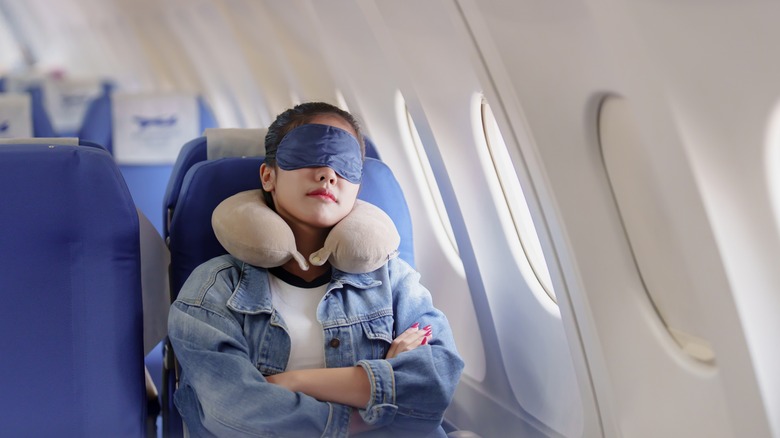The Unexpected Reason It's Risky For Plane Passengers To Be Asleep During Takeoff And Landing
Once you're strapped into the metal tube known as an airplane, your entertainment options are, well, incredibly limited. You could attempt to raw dog the whole flight and stare into the abyss, chat up your neighbor (only if they're willing to indulge you, of course), or pretend to be productive by catching up on some backlog projects — bonus points if you're in one of those productivity-boosting seats to get work done. Or, you could watch "Crazy Rich Asians" for the umpteenth time, a tried-and-true classic for the skies (seriously, ask anyone). But on a particularly lengthy flight, the best option is to snooze. You're at 30,000 feet, with no escape in sight — might as well get comfy and drift off.
That said, before you ship yourself to dreamland, here's a pro tip: Avoid dozing off during takeoff and landing unless you're dying to experience "airplane ear." Sleeping through these phases might sound tempting, but Dan Bubb, a professor at the University of Nevada, Las Vegas, cautions that napping at these times can mess with your ear pressure in a major — and painful — way. "When we are asleep, we don't swallow as much to equalize the pressure in our ears," he told Travel + Leisure.
And, of course, it also goes without saying that there's another, more practical reason to stay alert: Takeoff and landing are prime times to keep an eye out for, you know, emergencies. "The other reason to avoid sleeping during takeoff and landing is to be fully aware of what is happening if there is an emergency and passengers and crew members need to evacuate the airplane," he added. In short, you're free to rest up by all means — but maybe wait until you're in the clear.
Why 'airplane ear' happens
Flying does a number on our bodies, and it's not exactly pretty. Feeling extra bloated? Check. Find your ankles suddenly swelling? Double-check. And if that wasn't enough, your sense of taste suddenly takes a nosedive, and sometimes, only certain types of headphones can make plane food seem palatable. But the ultimate in-flight annoyance? The infamous "airplane ear," formally known as ear barotrauma. You'll know it by that all-too-familiar ear "pop" that usually hits hardest during takeoff and landing — and if you're snoozing through it, you're missing out on the one chance to fight it.
"Certain travelers will experience ear pain or clogging due to the pressure-relieving system in the inner ear, which balances pressure on the eardrum (eustachian tubes)," Dr. Bob Bacheler, DNP, CFRN, CCRN, flight physiology educator, explained to CNN. "The inner ear is much better at equalizing decreasing pressure (assent) than it is at relieving decreasing pressure (descent). It's the exact same reason why so many babies start to cry when a plane is landing."
And in rare cases, the pressure change can be severe enough to do more than just irritate. Dr. Richard Lebowitz, an ENT specialist at NYU Langone Medical Center, warns that if the pressure builds up too much, the eardrum can rupture. "It's not like blood's going to be pouring out of someone's ear, but if you were to look in their ear, or if someone put their finger at the ear canal or just looked at the edge of the canal, there could be some blood for sure," he told Thrillist. "If that happens, that means the eardrum ruptured, and that can happen on an airplane." Thankfully, they can usually heal on their own, but a ruptured eardrum is not exactly a fun souvenir from your flight.
Ways to relieve the dreaded 'airplane ear'
There's no foolproof way to avoid airplane ear altogether — after all, you're hurtling through the sky at dizzying speeds. But there are ways to make it more manageable. The best trick? Stay awake during takeoff and landing, obviously, so you can actually do something about it. For mild cases, simple actions can help ease the pressure. "Ways to open the eustachian tube include swallowing, yawning and blowing the nose," Dr. Bradley B. Block, an otolaryngologist-head and neck surgeon, told The Huffington Post. "Sometimes lozenges or gum are recommended because they cause more salivation, which leads to more swallowing."
If that doesn't cut it, there are other go-to methods. "The Valsalva maneuver, where one pinches the nose and gently blows while keeping the mouth closed, can also work," Dr. John Whyte, chief medical officer at WebMD, shared with the outlet. "Over-the-counter decongestants or nasal sprays may assist in relieving congestion, which can change the pressure difference."
On Reddit, some frequent fliers with intense ear pain swear by special earplugs and even recommend picking certain aircraft models for more comfortable pressure levels. "Try to look out for specific plane models. The newer planes compress the cabin to 6000ft instead of 8000ft, which DRASTICALLY reduces pressure related ear pain. A380, a350 and 787 are all planes that do this," they suggest. And, of course, if the pain becomes unbearable, it's best to seek medical advice before your next flight. No one wants airplane ear to become anything worse — and it most definitely shouldn't have to ruin your entire flight experience.


